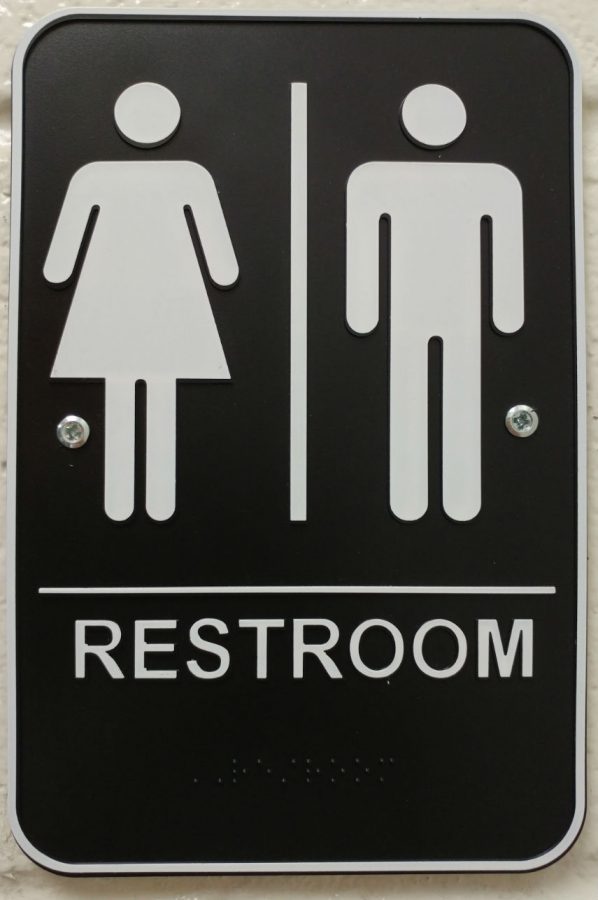Bathroom Wars: The New Frontier
Gender-neutral bathrooms stir up questions of discrimination
Administration repurposed the visitor and adult bathrooms across from the front office to be gender-neutral to accommodate “all of our people,” principal Allen Leonard said. Student Jane Smith* said this change was prompted by parent complaints of people who feel uncomfortable with her using the girls’ bathroom.
May 23, 2016
“The Bathroom Wars” in North Carolina have been in the news for the past couple of months, bringing up the question of transgender rights and legal discrimination against the LGBT community.
Starr’s Mill already addressed this problem a month into the school year. Principal Allen Leonard, superintendent Joseph Barrow and a now-retired deputy superintendent made the collaborative decision to repurpose the visitor and adult bathrooms across from the front office into gender-neutral restrooms.
This decision was made to be inclusive to all students at the Mill. “Having restrooms like this also allows us to make sure we’re serving all of our people,” Leonard said.
Student Jane Smith* uses these bathrooms everyday, and she said she’s never noticed any other students who use them regularly. “Mr. Leonard asked that I specifically go there,” said Smith, who would use the girls’ restroom otherwise.
If Leonard insists that “they’re just bathrooms,” then why did he suggest Smith use them?
Smith is transgender, and a “number of sources” reported to Leonard that they would feel uncomfortable if she used the girls’ bathroom.
Smith said, “It wasn’t students, it was parents of students,” who voiced their concern to administration about the bathroom arrangement. “They said they were planning on doing it anyways,” Smith said, “but I think they did it because of the demand of people who wanted to not let me into the girls’ bathroom.”
‘We had some reports that it may help all of our students feel more comfortable…’
— Principal Allen Leonard
But where does Leonard say the idea originated? He had to think about this question before answering. “We had some reports that it may help all of our students feel more comfortable and also allow for easier access to facilities for all of our people,” Leonard said after a significant pause.
This problem isn’t exclusive to Starr’s Mill. The Fannin County school system in North Georgia is having similar parent complaints, and Fannin Middle resource officer Anthony Walden and other parents said that allowing boys and girls to use the same restrooms goes against their Christian values.
Fannin County School Attorney Lynn Doss said that a unisex bathroom isn’t a solution if only one student is transgender because “then you’re singling that child out,” which counts as discrimination toward that student and could cause a loss of federal funds because of Title IX guidelines against sex discrimination.
This issue brings up the questions of whether the sex discrimination and equal protection laws extend to sexual identity and gender expression. Transgender rights activists claim that Title VII also classifies singling out transgender people as discrimination.
The Department of Education’s Office for Civil Rights added a memo to the interpretation of Title IX and said that the protections against sex discrimination extends to transgender students. “When a school elects to separate or treat students differently on the basis of sex . . . a school generally must treat transgender students consistent with their gender identity,” the OCR wrote.
In a phone interview, the OCR of Atlanta said that cases like these are still unresolved in Washington D.C., but cases such as the Grimm v. Gloucester County School Board indicate that Washington is leaning toward creating more defined regulations in favor of protection of transgender students.
On May 13, the Obama administration released guidelines for public schools advising schools to let transgender students use the bathroom that matches their gender identity. While this statement is not an order, there is a threat that failure to comply could result in the loss of federal funding.
‘[T]heir rationale was that they didn’t want a boy in the girls’ bathroom…and I’m not a boy.’ — Student Jane Smith*
How could these rulings affect students at Starr’s Mill?
As of now, the current rules about bathroom use may be considered discriminatory in a court setting, especially since Smith is the only transgender student she knows about at the school.
“I feel like [gender-neutral bathrooms are] thoughtful,” Smith said, “but it’s also slightly discriminating because it’s saying we’re not just normal boys and girls that belong in regular bathrooms.”
The bathrooms didn’t undergo many changes to be classified as gender-neutral. The existing decor remains and one bathroom still has a urinal.
The school added locks “because they are gender-neutral, so we wanted to make sure that whoever was in there had privacy,” Leonard said, “and we changed the signs.”
Smith said she doesn’t lock the entire bathroom and treats it just as she would the girls’ restroom.
To some students, the addition of the locks seems unnecessary. “If she goes in the stall, why does it matter?” senior Tyler Jeffares said.
But this change went unnoticed by much of the student body, and those who did know weren’t affected by the repurposing. “We used to use those bathrooms all the time during color guard,” senior Arisha Ali said, “and I had no idea they were changed to ‘gender-neutral’.”
While some students are able to ignore the change, the new bathroom arrangement is an everyday reality for Smith. “[It makes me feel] kind of misunderstood because their rationale was that they didn’t want a boy in the girls’ bathroom,” she said, “and I’m not a boy.”
*The name of this student was changed in accordance with guidelines from the Federal Educational Rights and Privacy Act which “generally prohibits the improper disclosure of personally identifiable information derived from education records.”

















Marcia • May 30, 2016 at 12:12 am
Erin and Faith,
I read the edited version of your story in The Citizen newspaper and it was a standout. How refreshing to read a NEWS article that was objective! You obviously understand the difference between writing an op/ed piece and reporting the news. Some people on The Citizen staff could learn from you.
The only exception to your objectivity was the one sentence that read, “If Leonard insists that ‘they’re just bathrooms,’ then why did he suggest Smith use them?'” I am wondering why that sentence was included in the article. Its tone did not match the rest of the article, nor did it match the factual, stick-to-the-facts nature of the rest of the news story. I have to wonder if it reflects editing of your original report. Please explain.
Good luck to both of you in your university studies.
Christi Ware • May 23, 2016 at 3:59 pm
Informative, thoughtful, and well-written. Great job, Erin and Faith!
Chris Maury • May 23, 2016 at 12:39 pm
Not a comment for the website, but I just wanted to say great job on the article. Well done.